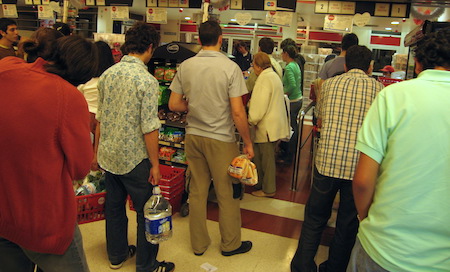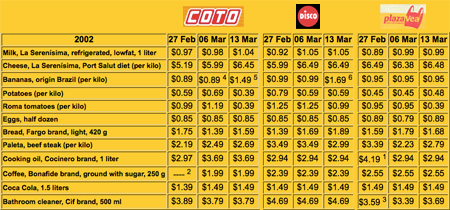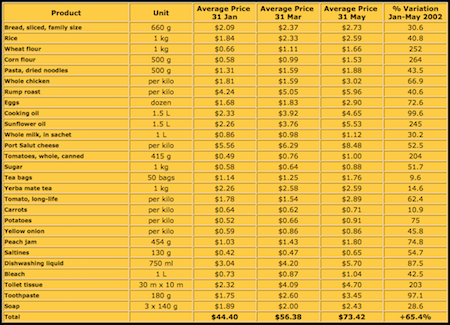
Many people are complaining about rising prices on basic food items. At the grocery store in mid-February, a woman told me she thought Argentines were cowards for putting up with price increases… an interesting opinion. I’m not sure what she would do, but my idea is to stick with a group of basic food products & monitor prices at the three largest chain supermarkets over the next few weeks. One of the first big news stories after devaluation was the rise of bread prices by 30%. Now the milk industry is following suit.
In addition, imported products are now out of reach for many Argentines. For example, Special K cereal, imported from South Africa, went from $3.75 to $4.39 in 3 weeks, representing a 15% increase. Fruit & vegetable prices have generally remained at previous levels, again except in the case of imports. Bananas are a good example. Formerly imported from Ecuador, prices skyrocketed from an average of $0.95/kilo to $1.89/kilo. As a result, most bananas consumed in Argentina are now from Brazil. Since Brazil is part of the Mercosur trade alliance, import duties are waived making their products more competitive. Brazilian bananas have exactly the same flavor as those from Ecuador but are often smaller and have a shorter shelf life. As of 21 April 2002, Special K is at $7.13 —a 90% increase in price!
Food items are not the only products with higher prices. Another battle between government & industry to maintain constant prices has been fought for home appliances. The majority are manufactured in Argentina (carrying the Industria Argentina label), but their price structure is higher due to imported component parts. Here’s what I found:
1 Plaza Vea did not have the same size bottle. Their product was 1.5 liters, but the packaging said 1/2 liter was free. Not really.
2 Coto only had 500 g bags.
3 Plaza Vea did not have the exact same product. Other similar cleaners of the same brand were at the price quoted.
4 Coto also had bananas from Ecuador at $1.49/kilo.
5 From Brazil!
6 Bananas from Ecuador were the only option.
Many consumer protection groups exist in Argentina, & one of the most cited is ADELCO (Liga de Acción del Consumidor, or Consumer Action League). They performed a much wider survey than I could, including all major supermarket chains & many more products. Unfortunately they did not include brand names in their study, but at least they investigated the same time period as I did. In spite of some large differences between highest and lowest price, the ADELCO survey points to a 3% average rise in prices during the first two weeks in the table above. This reflects what I found at Disco, with Plaza Vea remaining steady & Coto increasing 8.5%. Most products are more expensive than before devaluation, regardless of supermarket chain.
ADELCO issues weekly press releases with food price comparison statistics & also available on their website. Although text is in Spanish, food names are easily understood. In addition to the weekly report, much more revealing statistics about the rise in food prices are now available with monthly comparisons since devaluation. Comparing the end of January with the end of May, the general price increase is alarming.
[Originally posted in Argentina Experienced, a website I created to document living in Buenos Aires after the 2001 economic crisis. Text has been edited for style. Definitions of econ terms can be found in the glossary. Politician biographies may help, as well as a summary of recent history & current events.]

